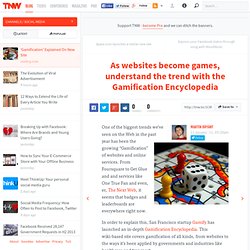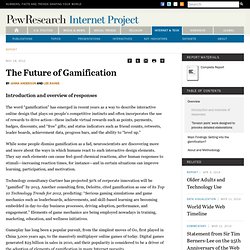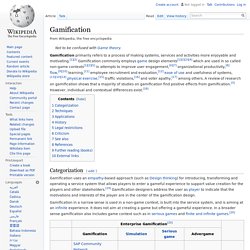

Business Intelligence for the Games & Entertainment Industry. Gamification, Social Media, Technology, Games - Andrzej's Blog. Can HighScore House Actually Help Your Kids Do Their Chores? - Lockergnome. As websites become games, understand the trend with the Gamification Encyclopedia. 11 January '11, 03:20pm Follow One of the biggest trends we’ve seen on the Web in the past year has been the growing “Gamification” of websites and online services.

From Foursquare to Get Glue and and services like One True Fan and even, er, The Next Web, it seems that badges and leaderboards are everywhere right now. In order to explain this, San Francisco startup Gamify has launched an in-depth Gamification Encyclopedia. GreenGoose - Play Real Life. Yu-kai Chou & Gamification.
Gamification-Education-and-Behavioural-Economics-v1.pdf (Objet application/pdf) Fun is the Future: Mastering Gamification. Meaningful Play: Getting Gamification Right. From Gamification to Intelligence Amplification to The Singularity. “Moore’s law became obsolete as far as graphics were concerned.

Moore’s law was doubling. It was accelerating so fast that NVida started calling it Moore’s law cubed.” The following article was edited by R.U. Sirius and Alex Peake from a lecture Peake gave at the December 2010 Humanity+ Conference at the Beckman Institute in Pasadena, California. The original title was “Autocatalyzing Intelligence Symbiosis: what happens when artificial intelligence for intelligence amplification drives a 3dfx-like intelligence explosion.”
I’ve been thinking about the combination of artificial intelligence and intelligence amplification and specifically the symbiosis of these two things. And the question that comes up is what happens when we make machines make us make them make us into them? There are three different Moores’ Laws of accelerating returns. We could be right in the middle of an autocatalytic reaction and not know it. There are two specific processes that I think are auto-catalyzing right now. Seth Priebatsch: The game layer on top of the world.
Jane McGonigal: Gaming can make a better world. Jane McGonigal: The game that can give you 10 extra years of life. Reflections and Concerns about Gamification (Part I) (Cross-posted from Aaron’s Blog) I’ve been a member of Gamespot – a website dedicated to news and discussion on videogames – since 2003.

My rank on it is Super Bagman (Level 23), which I gather isn’t particularly high, since the site suggests you can go up to at least Level 71. I also have a list of achievements for having done mundane things, such as registering for the site, voting for the game of the year, and being a “New Game Ninja,” whatever that means. The details about levelling up in rank isn’t displayed prominently, so I had to do some digging around to find it. Here’s a passage that gives you some idea of what levelling up means: To level up on GameSpot, all you need to do is to spend your time here. Common ways of spending time here include but are not limited to: visiting the forums, posting, reading articles and blogs, watching videos, updating your profile etc. Gamification: Rules Rule, But Shouldn’t Rule Everything. The Future of Gamification. Introduction and overview of responses The word “gamification” has emerged in recent years as a way to describe interactive online design that plays on people’s competitive instincts and often incorporates the use of rewards to drive action—these include virtual rewards such as points, payments, badges, discounts, and “free” gifts; and status indicators such as friend counts, retweets, leader boards, achievement data, progress bars, and the ability to “level up.”

While some people dismiss gamification as a fad, neuroscientists are discovering more and more about the ways in which humans react to such interactive design elements. They say such elements can cause feel-good chemical reactions, alter human responses to stimuli—increasing reaction times, for instance—and in certain situations can improve learning, participation, and motivation.
Technology consultancy Gartner has projected 50% of corporate innovation will be “gamified” by 2015. 42% agreed with the statement: How Multiplayer Games Will Change the Future of Work. The Gamification of Life. On last week’s edition of Spark, my new favorite podcast, the topic was games and the first segment was a very interesting discussion with Jesse Schell, a game designer who also teaches at the Entertainment Technology Center at Carnegie Mellon University.

His thesis is that, while games of one kind or another have always been with us, the ability to store and access huge quantities of data in the 21st century is bringing about the “gamification” of life. The whole discussion is worth listening to (an extended version is also on the show site) but there were two pieces that stood out for me. First, is Schell’s view of school as gaming. People are already talking about how to reorganize [using gaming techniques] school because school is already a kind of a game. You go they have tasks, you do the tasks, you get a score. The Game-ification of Life. Core Concepts of Gamification. Outstanding presentation from Amy Jo Kim, an adjunct professor of Game Design at USC’s Digital Media school, recently named top US-based game design school.

She’s also the author of Community Building on the Web (2000), a design handbook for digital communities that’s used worldwide at game studios & universities. [Email Amy]. This presentation was delivered at Casual Connect Seattle, July 2011. A few of the highlights of the presentation and how they compare to sales and marketing: “What are your social engagement words?” My mind map from the presentation:
Green Gamification: Combining Social Media & Game Mechanics to Promote Sustainability. Games are like ketchup: widely loved and diversely applied, with an appeal rooted in childhood.

In fact, a new report reveals that over 90% of U.S. kids aged 2- 17 are gaming today. Yet the gaming generation has been on the rise for three decades, leading to not only an army of young gamers, but also an influential adult segment. It is small wonder, then, that “gamification” is the most disruptive force to impact marketing since the arrival of social media.
Typically defined, gamification refers to the use of game mechanics, such as points, badges, leaderboards and challenges in non-game settings. Traditional examples include airline frequent flyer programs and “Buy 10, Get 1 Free” loyalty offers. Gamification: Insights And Emerging Trends. Editor’s note: Tim Chang is a managing director at Mayfield Fund.

Follow Tim on Twitter @timechange. He’s hosting a workshop on gamification at the Mayfield Fund offices on June 6 and has reserved 10 spots for TechCrunch readers — more details at the end of this post. Social Competition = Gamification + Engagement. According to Merriam Webster , competition is defined as 1 : the act or process of competing : rivalry : as a : the effort of two or more parties acting independently to secure the business of a third party by offering the most favorable terms b : active demand by two or more organisms or kinds of organisms for some environmental resource in short supply. Education Levels Up! – A noObs guide to Gamifying your Classroom. A new way to manage classroom instruction is slowly creeping into the world of education: “Gamification“.

Gamifying simply means turning the class content and the way students learn into a game with a rewards system, quests, experience levels, and healthy competition. Gamifying isn’t anything new; businesses and social websites have been using “gaming” to attract and keep users coming back for years now. Gamification. Gamification. Categorization[edit]

Gamification. EnGaming is dedicated to delivering the best Gamification info to improve your customer loyalty and engagement for your brands, products, and services. Gamification. About the Course Gamification is the application of digital game design techniques to non-game contexts, such as business, education, and social impact challenges.
Video games are the dominant entertainment form of modern times because they powerfully motivate behavior. Game mechanics can be applied outside the immersive environments of games themselves, to create engaging experiences as well as assign rewards and recognition. Over the past few years, gamification adoption has skyrocketed. The Beginner's Guide to Gamification (5 of 90): The 4 Experience Phases of a Game.
Gamification and Game Mechanics Guide. Gamification Research Network. Defining gamification - what do people really think? As many of you know, I recently took exception to a particular definition of gamification that was doing the rounds. However, the positive effect was to make me think about what it really means and also started to make me wonder what other people think of it. So, I asked them – I did a little research… The results were interesting.
Gamification Industry. Gamasutra - The Art & Business of Making Games. Gartner is Soooooo Wrong about Gamification... Brian Burke just published an updated definition of Gamification, trying to clarify what gamification is and what is not. According to this new “official” definition of Gamification by Gartner, gamification is “the use of game mechanics and experience design to digitally engage and motivate people to achieve their goals”. And, as many other important voices in the gamification world (see the comments by Andrzej Marczewski, Mario Herger, Roman Rackwitz, etc. in the comments of the post), I find this new definition both wrong and confusing. Digitally Engage? I agree with most of the comments in Brian Burke’s post. If we limit gamification to what is in the digital world, we are loosing a lot of interesting applications of gamification, for example gamification in the classroom, where it’s usually implemented using physical and not digital technologies (because they’re cheaper in most cases, and easier to understand by kinds).
In fact, I think we don’t live in the digital or the real world. Gamification. Gamification is the use of game style thinking and interactions to solve problems and generate new understandings. Competitive Gaming Traditionally the concept of a ‘Game’ is that of a ‘winner’ who beats the others playing the game on the performance of a task, this I call ‘Competitive Gaming’. Gamify - Everything's a Game.
Gamification Blog. Game Mechanics « Strategic Synergy. How much does it cost you to moderate your online community? The History of Gamification Infographic: From Stamps to Space. The Science of Gamification - COLLOQUY. The Gamification of Loyalty – Part Three of An Eight-Part Series. Gamification Times. Learning and sharing in a virtual world by Steve Dale. Gamification Summit - Sep 15 – 16. S2T4W3: Gamification, Funware, Puzzle Building, Professor Teaches. 1.